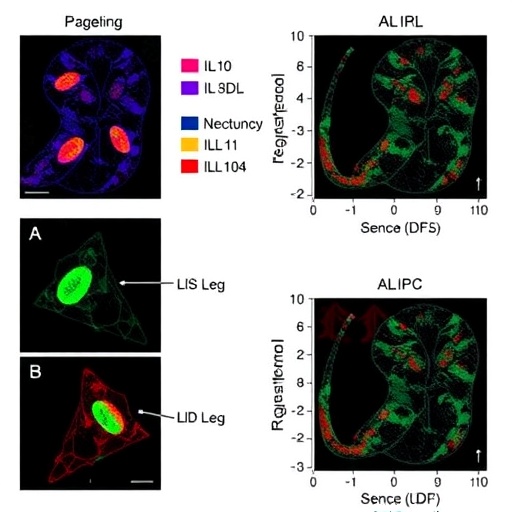Scientist identifies new areas in human genomes linked to risk

Credit: IU School of Medicine
INDIANAPOLIS — An Indiana University cancer researcher has identified eight new genomic regions that increase a person’s risk for skin cancer.
Jiali Han, Ph.D., and colleagues discovered eight new loci–locations on a person’s genome–that are susceptible to the development of squamous cell skin cancer. Han is the Rachel Cecile Efroymson Professor in Cancer Research at IU School of Medicine, professor and chair of the Department of Epidemiology at the IU Richard M. Fairbanks School of Public Health at IUPUI, and a researcher at the Indiana University Melvin and Bren Simon Cancer Center.
Researchers previously identified 14 loci with increased risk for squamous cell skin cancer. This study confirmed those findings while adding eight new genomic locations, bringing the total identified risk loci to 22. Their research is published this month online in Nature Communications.
“This is the largest genetic-associated study for squamous cell carcinoma of the skin,” Han, an epidemiologist, said. “Our multidisciplinary research sheds light on new biology and the etiology of squamous cell carcinoma, confirming some important genes and also identifying genes involved in this particular cancer development.”
Han and colleagues analyzed six international cohorts totaling approximately 20,000 squamous cell skin cancer cases and 680,000 controls, or people who haven’t had squamous cell skin cancer. More than one-third of the genomic data came from genetic testing company 23andMe research participants. Additional datasets came from the Nurse’s Health Study, Health Professionals Follow-up Study, the Icelandic Cancer Registry and the Ohio State University Division of Human Genetics sample bank.
Research findings confirmed that pigmentation genes can also be a person’s skin cancer susceptibility gene, but they also identified additional molecular pathways.
“We can certainly say there is some genetic overlap between squamous cell carcinoma, basal cell carcinoma and melanoma–the three major types of skin cancer–but we also found some genes are specific for squamous cell carcinoma,” Han said.
Squamous cell and basal cell are also known as non-melanoma skin cancers. Both usually respond to treatment and rarely spread to other parts of the body, according to the National Cancer Institute. Melanoma is more aggressive, however, and can spread to other parts of the body if it’s not diagnosed early.
Physical genomic traits such as fair skin, freckles, blue eyes and brown hair were associated with the risk loci. Researchers have long known that fair skin and sun exposure are risk factors for squamous cell skin cancer.
“Avoiding sun exposure is always the primary prevention strategy, regardless of your skin pigmentation,” Han said.
Han and collaborators are continuing to build the population sample to identify more risk loci. Even with the 22 genomic regions identified, the study found those explain only 8.5 percent of the heritable risk for squamous cell skin cancer.
###
Kativa Sarin, M.D., Stanford University School of Medicine, is the co-lead author. Additional authors of the study are Yuan Lin and Wenting Wu, Fairbanks School of Public Health; Roxana Daneshjou, Adam Rubin, Paul Khavari and Alice Whitemore, Stanford University; Andrey Ziyatdinov and Peter Kraft, Harvard T.H. Chan School of Public Health; Gudmar Thorleifsson and Simon N. Stacey, deCODE genetics/Amgen Inc., Reykjavik, Iceland; Luba M. Pardo, Tamar Nijsten, Andre Uitterlinden, Erasmus University Medical Center, Rotterdam, The Netherlands; Amanda E. Toland, Ohio State University Comprehensive Cancer Center; Jon H. Olafsson, Bardur Sigurgeirsson and Kristin Thorisdottir, Landspitali-University Hospital and University of Iceland, Reykjavik, Iceland; Eric Jorgensen, Kaiser Permanente Northern California; Kari Stefansson, University of Iceland; and Maryam M. Asgari, Massachusetts General Hospital.
The study was supported in part by grants from the National Human Genome Research Institute of the National Institutes of Health (grant number R44HG006981), the National Cancer Institute (R01 CA49449, P01 CA87969, UM1 CA186107, UM1 CA167552, R03 CA219779, K23 CA211793) and Indianapolis-based Walther Cancer Foundation.
Media Contact
Michael Schug
[email protected]
317-278-0953
Original Source
https:/
Related Journal Article
http://dx.




